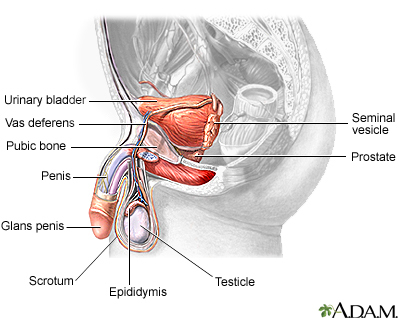Scrotal swelling
Definition
Scrotal swelling is abnormal enlargement of the scrotum. This is the name for the sac surrounding the testicles.
Alternative Names
Swelling of the scrotum; Testicular enlargement
Considerations
Scrotal swelling can occur in males at any age. The swelling can be on one or both sides, and there may be pain. The testicles and penis may or may not be involved.
In testicular torsion, the testicle becomes twisted in the scrotum and loses its blood supply. It is a serious emergency. If this twisting is not relieved quickly, the testicle may be permanently lost. This condition is extremely painful. Call 911 or the local emergency number, or see your health care provider immediately. Losing blood supply for just a few hours can cause tissue death and the loss of a testicle.
Causes
Causes of scrotal swelling include:
- Certain medical treatments
- Congestive heart failure
- Epididymitis
- Hernia
- Hydrocele
- Injury
- Orchitis
- Surgery in the genital area
- Testicular torsion
- Varicocele
- Testicular cancer
- Fluid retention
Home Care
Things you can do to help this problem include:
- Apply ice packs to the scrotum for the first 24 hours, followed by sitz baths to decrease swelling.
- Elevate scrotum by placing a rolled up towel between your legs. It will help relieve pain and swelling.
- Wear a loose-fitting athletic supporter for daily activities.
- Avoid excessive activity until the swelling disappears.
When to Contact a Medical Professional
Call your provider if:
- You notice any unexplained scrotal swelling.
- The swelling is painful.
- You have a testicle lump.
What to Expect at Your Office Visit
Your provider will perform a physical exam and take a medical history, which may include the following questions:
- When did the swelling develop? Did it come on suddenly? Is it getting worse?
- How big is the swelling (try to describe in terms such as "twice normal size" or "the size of a golf ball")?
- Does the swelling appear to be fluid? Can you feel tissue in the swollen area?
- Is the swelling in one part of the scrotum or in the entire scrotum?
- Is the swelling the same on both sides (sometimes a swollen scrotum is actually an enlarged testicle, a testicular lump, or a swollen duct)?
- Have you had surgery, injury, or trauma in the genital area?
- Have you had a recent genital infection?
- Does the swelling go down after you rest in bed?
- Do you have any other symptoms?
- Is there any pain in the area around the scrotum?
The physical exam will most likely include a detailed exam of the scrotum, testicles, and penis. The combination of a physical exam and history will determine whether you need any tests.
Your provider may prescribe antibiotics and pain medicines, or recommend surgery. A scrotal ultrasound may be done to find where the swelling is occurring.
Gallery

References
Elder JS. Disorders and anomalies of the scrotal contents. In: Kliegman RM, St. Geme JW, Blum NJ, Shah SS, Tasker RC, Wilson KM, eds. Nelson Textbook of Pediatrics. 21st ed. Philadelphia, PA: Elsevier; 2020:chap 560.
Germann CA, Holmes JA. Selected urologic disorders. In: Walls RM, Hockberger RS, Gausche-Hill M, eds. Rosen's Emergency Medicine: Concepts and Clinical Practice. 9th ed. Philadelphia, PA: Elsevier; 2018:chap 89.
Kryger JV. Acute and chronic scrotal swelling. In: Kliegman RM, Lye SP, Bordini BJ, Toth H, Basel D, eds. Nelson Pediatric Symptom-Based Diagnosis. Philadelphia, PA: Elsevier; 2018:chap 21.
Palmer LS, Palmer JS. Management of abnormalities of the external genitalia in boys. In: Partin AW, Domochowski RR, Kavoussi LR, Peters CA, eds. Campbell-Walsh-Wein Urology. 12th ed. Philadelphia, PA: Elsevier; 2021:chap 44.